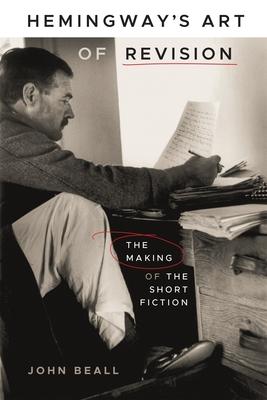In Hemingway's Art of Revision, John Beall analyzes more than a dozen pieces of the author's celebrated short fiction, with a focus on manuscripts and typescripts, as part of a broader examination of how Ernest Hemingway crafted his distinctive prose through a rigorous process of revision.
Ranging from two vignettes in the first version of In Our Time through early touchstones such as "Indian Camp" and "The Killers" to later masterpieces including "Fathers and Sons," Beall's study considers the modernist influences, aesthetic choices, and experimental effects that characterized Hemingway's approach to the short story. Revisions to "Big Two-Hearted River," for example, were not simply cuts and omissions, but involved adding paragraphs to slow down the narrative and represent Nick Adams's careful observations of fish as he watched their shadows on the river. For "A Way You'll Never Be," Hemingway's revisions developed Nick's interior monologues, manic lecture about grasshoppers, and wacky sense of humor to show the character restoring a sense of emotional balance despite his traumatic memories of being wounded. By drawing attention to the meticulous omissions, additions, and replacements that shaped these texts, Beall reveals how extensively and richly Hemingway revised his drafts. Hemingway's Art of Revision gives a detailed view of a great prose stylist at work.
Book
Hemingway's Art of Revision: The Making of the Short Fiction
by John Beall
(Write a Review)
Hardcover
$49.95
In Hemingway's Art of Revision, John Beall analyzes more than a dozen pieces of the author's celebrated short fiction, with a focus on manuscripts and typescripts, as part of a broader examination of how Ernest Hemingway crafted his distinctive prose through a rigorous process of revision.
Ranging from two vignettes in the first version of In Our Time through early touchstones such as "Indian Camp" and "The Killers" to later masterpieces including "Fathers and Sons," Beall's study considers the modernist influences, aesthetic choices, and experimental effects that characterized Hemingway's approach to the short story. Revisions to "Big Two-Hearted River," for example, were not simply cuts and omissions, but involved adding paragraphs to slow down the narrative and represent Nick Adams's careful observations of fish as he watched their shadows on the river. For "A Way You'll Never Be," Hemingway's revisions developed Nick's interior monologues, manic lecture about grasshoppers, and wacky sense of humor to show the character restoring a sense of emotional balance despite his traumatic memories of being wounded. By drawing attention to the meticulous omissions, additions, and replacements that shaped these texts, Beall reveals how extensively and richly Hemingway revised his drafts. Hemingway's Art of Revision gives a detailed view of a great prose stylist at work.Hardcover
$49.95